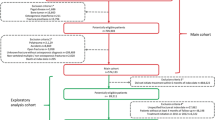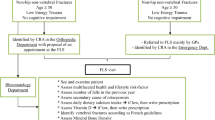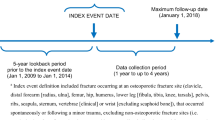Abstract
Background
Osteoporosis is the most common condition contributing to 95% of fractures in older patients hospitalized for fracture treatment. Despite the significant impact of fragility fractures on patient morbidity and mortality, efforts in optimizing osteoporotic treatment and prevention remain inadequate. In contrast, in patients with limited life expectancy, withholding specific osteoporosis drug treatment appears reasonable. The threshold between under- and overtreatment is still unclear.
Methods
In 2016, we implemented a fracture liaison service (FLS) for 18 months to improve the quality of osteoporosis care. We collected prospectively the patient’s history, current treatment for osteoporosis, and risk factors for fragility fractures using a standardized protocol. Recommendations for drug therapy are discussed during the interdisciplinary ward round. The primary outcome parameter was a recommendation for specific osteoporosis drug treatment. We included 681 patients (mean age 82.5 years, 502 (73.7%) females). The inclusion criteria were the following: age of 70 years or older, admission to geriatric fracture center between April 2016 and December 2018.
Results
Based on our data, specific osteoporosis drug therapy was recommended in 467 (68.6%) patients. Six hundred fifty-one (95.6%) patients received vitamin D3, and 546 (80.2%) calcium. After adjustment, only age (every 5 years, OR 0.57; 95% CI 0.45–0.72; p < 0.0001), cognitive impairment (OR 0.41; 95% CI 0.23–0.74; p = 0.003), pre-fracture mobility (OR 1.54; 95% CI 1.34–1.75; p < 0.0001), and living in a nursing home (OR 0.52; 95% CI 0.27–0.99; p = 0.049) remained as independent predictors for an indication of specific osteoporosis drug therapy.
Conclusion
We found a higher rate of recommendations for specific osteoporosis drug therapy compared with usual treatment rates in literature. Though in some cases withholding of specific osteoporosis drug therapy seems reasonable, the main proportion of fragility fracture patients is undertreated. Our results could be a benchmark for the quality of osteoporosis care in older fragility fracture patients treated in a geriatric fracture center.


Similar content being viewed by others
References
Leung F, Blauth M, Bavonratanavech S (2010) Surgery for fragility hip fracture-streamlining the process. Osteoporos Int 21(Suppl 4):S519–S521
Bogoch ER, Elliot-Gibson V, Beaton DE, Jamal SA, Josse RG, Murray TM (2006) Effective initiation of osteoporosis diagnosis and treatment for patients with a fragility fracture in an orthopaedic environment. J Bone Joint Surg Am 88(1):25–34
Haussler B, Gothe H, Gol D, Glaeske G, Pientka L, Felsenberg D (2007) Epidemiology, treatment and costs of osteoporosis in Germany--the BoneEVA study. Osteoporos Int 18(1):77–84
Hadji P, Klein S, Gothe H, Haussler B, Kless T, Schmidt T et al (2013) The epidemiology of osteoporosis--Bone Evaluation Study (BEST): an analysis of routine health insurance data. Dtsch Arztebl Int 110(4):52–57
Johnell K, Fastbom J (2009) Undertreatment of osteoporosis in the oldest old? A nationwide study of over 700,000 older people. Arch Osteoporos 4(1–2):17–23
Jennings LA, Auerbach AD, Maselli J, Pekow PS, Lindenauer PK, Lee SJ (2010) Missed opportunities for osteoporosis treatment in patients hospitalized for hip fracture. J Am Geriatr Soc 58(4):650–657
Charlson ME, Pompei P, Ales KL, MacKenzie CR (1987) A new method of classifying prognostic comorbidity in longitudinal studies: development and validation. J Chronic Dis 40(5):373–383
Parker MJ, Palmer CR (1993) A new mobility score for predicting mortality after hip fracture. J Bone Joint Surg (Br) 75(5):797–798
Dachverband Osteologie e.V. Prophylaxe DuTdObpFubM. Leitlinie des Dachverbandes der Deutschsprachigen Wissenschaftlichen Osteologischen Gesellschaft e.V. 2017 [24.01.2019]. Available from: https://www.dv-osteologie.org/uploads/Leitlinie%202017/Finale%20Version%20Leitlinie%20Osteoporose%202017_end.pdf
nice.org.uk. Osteoporosis: fragility fracture risk https://www.nice.org.uk/guidance/cg146/evidence/full-guideline-pdf-1868183652012 [cited 2020 07.01.2020]
Strom O, Borgstrom F, Kanis JA, Compston J, Cooper C, McCloskey EV et al (2011) Osteoporosis: burden, health care provision and opportunities in the EU: a report prepared in collaboration with the International Osteoporosis Foundation (IOF) and the European Federation of Pharmaceutical Industry Associations (EFPIA). Arch Osteoporos 6:59–155
Edwards BJ, Bunta AD, Simonelli C, Bolander M, Fitzpatrick LA (2007) Prior fractures are common in patients with subsequent hip fractures. Clin Orthop Relat Res 461:226–230
Dehamchia-Rehailia N, Ursu D, Henry-Desailly I, Fardellone P, Paccou J (2014) Secondary prevention of osteoporotic fractures: evaluation of the Amiens University Hospital’s fracture liaison service between January 2010 and December 2011. Osteoporos Int 25(10):2409–2416
nice.org.uk. Bisphosphonates for treating osteoporosis https://www.nice.org.uk/guidance/ta464/resources/bisphosphonates-for-treating-osteoporosispdf-826049055566772017 [cited 2019 16.07.2019]
Curtis JR, Arora T, Matthews RS, Taylor A, Becker DJ, Colon-Emeric C, Kilgore ML, Morrisey MA, Saag KG, Safford MM, Warriner A, Delzell E (2010) Is withholding osteoporosis medication after fracture sometimes rational? A comparison of the risk for second fracture versus death. J Am Med Dir Assoc 11(8):584–591
Harvey NC, McCloskey E, Kanis JA, Compston J, Cooper C (2017) Bisphosphonates in osteoporosis: NICE and easy? Lancet. 390(10109):2243–2244
Poole KE, Treece GM, Gee AH, Brown JP, McClung MR, Wang A, Libanati C (2015) Response to: Comment on: “Denosumab rapidly increases cortical bone in key locations of the femur: a 3D bone mapping study in women with osteoporosis”. J Bone Miner Res 30(10):1939–1940
Boyd C, Smith CD, Masoudi FA, Blaum CS, Dodson JA, Green AR et al (2019) Decision making for older adults with multiple chronic conditions: executive summary for the American Geriatrics Society Guiding Principles on the Care of Older Adults With Multimorbidity. J Am Geriatr Soc 67(4):665–673
Delbaere K, Kochan NA, Close JC, Menant JC, Sturnieks DL, Brodaty H, Sachdev PS, Lord SR (2012) Mild cognitive impairment as a predictor of falls in community-dwelling older people. Am J Geriatr Psychiatry 20(10):845–853
Le Floch P, Kermarrec P, Gentric A (2019) Overwhelming underuse of bisphosphonates in French nursing home residents after proximal femoral fracture. J Nutr Health Aging 23(4):378–380
Aguilar EA, Barry SD, Cefalu CA, Abdo A, Hudson WP, Campbell JS, Reske TM, Bonafede M, Wilson K, Stolshek BS, Paoli CJ, Tran N, Cheng LI (2015) Osteoporosis diagnosis and management in long-term care facility. Am J Med Sci 350(5):357–363
Colon-Emeric C, Lyles KW, Levine DA, House P, Schenck A, Gorospe J et al (2007) Prevalence and predictors of osteoporosis treatment in nursing home residents with known osteoporosis or recent fracture. Osteoporos Int 18(4):553–559
Fleischman RJ, Adams AL, Hedges JR, Ma OJ, Mullins RJ, Newgard CD (2010) The optimum follow-up period for assessing mortality outcomes in injured older adults. J Am Geriatr Soc 58(10):1843–1849
Zullo AR, Zhang T, Lee Y, McConeghy KW, Daiello LA, Kiel DP, Mor V, Berry SD (2019) Effect of bisphosphonates on fracture outcomes among frail older adults. J Am Geriatr Soc 67(4):768–776
Crilly RG, Hillier LM, Mason M, Gutmanis I, Cox L (2010) Prevention of hip fractures in long-term care: relevance of community-derived data. J Am Geriatr Soc 58(4):738–745
Lyons RA, Johansen A, Brophy S, Newcombe RG, Phillips CJ, Lervy B et al (2007) Preventing fractures among older people living in institutional care: a pragmatic randomised double blind placebo controlled trial of vitamin D supplementation. Osteoporos Int 18(6):811–818
Funding
The overall financing was provided by the Theo und Friedl Schöllerstiftung, a private foundation located in Nuremberg, Germany. The funding has no influence on selection of data, its evaluation, or the decision to publish the results found.
Author information
Authors and Affiliations
Corresponding author
Ethics declarations
Conflict of interest
None.
Additional information
Publisher’s note
Springer Nature remains neutral with regard to jurisdictional claims in published maps and institutional affiliations.
Rights and permissions
About this article
Cite this article
Gosch, M., Bail, HJ., Grueninger, S. et al. What is a reasonable rate for specific osteoporosis drug therapy in older fragility fracture patients?. Arch Osteoporos 15, 20 (2020). https://doi.org/10.1007/s11657-020-0690-2
Received:
Accepted:
Published:
DOI: https://doi.org/10.1007/s11657-020-0690-2




